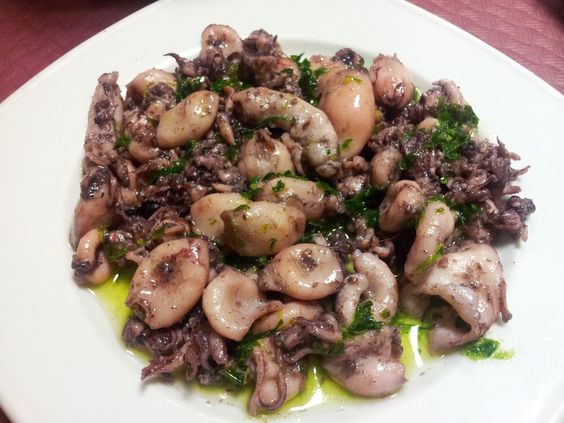If you’re exploring Spanish or Mediterranean cuisine, you’ve likely stumbled across chipirones on the menu. These tiny, tender squid, also known as baby squid, are a delicacy enjoyed in coastal regions, particularly in Spain. Smaller and more delicate than their full-grown counterparts, chipirones are prized for their sweet, mild flavor and tender texture.
They can be cooked in a variety of ways, from being grilled to fried, and even stuffed, offering versatility in preparation that reflects the Mediterranean love of fresh, simple ingredients.
To read about squid in Phnom Penh click here.
The Anatomy of Chipirones
Chipirones are essentially the younger, smaller versions of squid. They measure about 6-10 centimeters in length, making them bite-sized morsels perfect for tapas or light meals. Like adult squid, chipirones have a soft body, tentacles, and ink sacs. However, due to their size, they are generally more tender and have a subtler flavor than their larger relatives, such as calamares.
What makes chipirones special is that their small size allows them to be cooked whole, which provides a full sensory experience as you enjoy the crunch of the body along with the more delicate, slightly chewy tentacles.

Popular Preparations of Chipirones
Chipirones are a staple in Spanish tapas bars, where simplicity and the quality of ingredients shine. While there are many ways to prepare them, some of the most popular include:
1. Chipirones a la Plancha (Grilled Baby Squid)
This is one of the most iconic ways to serve chipirones. The baby squid are grilled on a hot plate (plancha), often with nothing more than a drizzle of olive oil, a sprinkle of sea salt, and maybe a touch of garlic or lemon. This method preserves the fresh flavor of the squid while giving it a slightly smoky char from the grill. The simplicity allows the natural sweetness and tenderness of the squid to be the star of the dish.
2. Chipirones Fritos (Fried Baby Squid)
A crowd-pleaser, chipirones fritos are usually lightly dusted in flour or breadcrumbs and deep-fried to crispy perfection. The result is a deliciously crunchy exterior, with a tender and juicy bite inside. They are often served with lemon wedges and sometimes a side of alioli, a garlicky mayonnaise-style dip. The contrast of the crispy coating with the delicate interior makes fried chipirones a beloved tapas dish.
3. Chipirones Encebollados (Baby Squid with Onions)
For those who prefer a heartier preparation, chipirones encebollados is a great option. In this dish, the baby squid are sautéed with onions, garlic, and sometimes a splash of wine or sherry, resulting in a rich, savory dish where the squid absorb the sweet flavors of caramelized onions. The tender squid in this preparation takes on a more luxurious, stewy texture and is often served with crusty bread for dipping into the flavorful sauce.
4. Stuffed Chipirones
In some regions, chipirones rellenos (stuffed squid) is a popular dish. The squid are typically stuffed with a mixture of their own tentacles, breadcrumbs, and other seafood or even chorizo. They are then cooked in a sauce made of tomato, onion, and garlic. The combination of the delicate squid and the rich filling makes for a wonderfully complex bite that’s both savory and sweet.
Click the link to read about Kep Crab Market
Chipirones and Mediterranean Culture
Chipirones have deep roots in Mediterranean and particularly Spanish culinary culture. The Iberian Peninsula, surrounded by the Atlantic Ocean and Mediterranean Sea, has long relied on seafood as a central part of its diet. The abundance of squid in these waters means that dishes like chipirones are not just a treat for tourists but an essential part of everyday cuisine for locals.
In many ways, chipirones encapsulate the Mediterranean approach to cooking: fresh ingredients, simple preparation, and an emphasis on letting the natural flavors shine through. Whether eaten as part of a leisurely tapas meal with friends or as a light lunch by the seaside, chipirones are a quintessential Mediterranean experience.
The Nutritional Benefits of Chipirones
Beyond their taste, chipirones are also highly nutritious. Like other squid varieties, they are a great source of lean protein, making them an excellent choice for those looking to enjoy seafood without the higher fat content of other meats. They are also rich in vitamins and minerals, including vitamin B12, phosphorus, and selenium. Additionally, squid, including chipirones, are low in calories and fat, making them a healthy option when prepared without heavy sauces or deep frying.
Where to Find the Best Chipirones
If you’re traveling through Spain, some of the best places to enjoy fresh chipirones include the coastal cities and towns where seafood is king. The Basque Country, Catalonia, and Andalusia are all known for their seafood markets and tapas bars where chipirones are a mainstay. In particular, San Sebastián and Barcelona offer excellent opportunities to try grilled or fried chipirones at local tapas bars.
For those not lucky enough to be wandering the streets of Spain, chipirones can also be found in specialty Spanish restaurants across the world. In countries with strong Spanish culinary influences, such as Argentina, you may also encounter variations of these delicious baby squid.
Conclusion: A Tapas Favorite to Savor
Chipirones are a true gem of Mediterranean cuisine, delivering on flavor, texture, and cultural heritage. Whether you prefer them grilled to perfection, fried to a golden crisp, or stewed in a flavorful sauce, chipirones are a must-try for any seafood lover. Their simplicity and versatility make them perfect for tapas or as part of a larger meal, offering a glimpse into the vibrant seafood culture of Spain and beyond.

